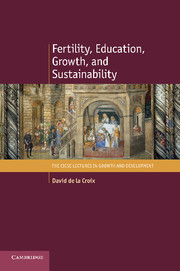Book contents
- Frontmatter
- Contents
- List of figures
- List of tables
- List of symbols
- List of definitions
- List of propositions
- Introduction
- PART ONE DIFFERENTIAL FERTILITY
- PART TWO EDUCATION POLICY
- PART THREE SUSTAINABILITY
- 7 Environmental collapse and population dynamics
- 8 Production, reproduction, and pollution caps
- 9 Population policy
- 10 Conclusion: endogenous fertility matters
- Bibliography
- Author index
10 - Conclusion: endogenous fertility matters
from PART THREE - SUSTAINABILITY
Published online by Cambridge University Press: 05 December 2012
- Frontmatter
- Contents
- List of figures
- List of tables
- List of symbols
- List of definitions
- List of propositions
- Introduction
- PART ONE DIFFERENTIAL FERTILITY
- PART TWO EDUCATION POLICY
- PART THREE SUSTAINABILITY
- 7 Environmental collapse and population dynamics
- 8 Production, reproduction, and pollution caps
- 9 Population policy
- 10 Conclusion: endogenous fertility matters
- Bibliography
- Author index
Summary
This book provides a set of general equilibrium models where heterogeneous households rationally choose their number of children.We show that if indeed fertility is not only determined by exogenous cultural factors but responds to economic incentives, it has important consequences for inequality, education, and sustainability.
First, as soon as one assumes that the most important cost of having children is a time cost, economic theory says that fertility negatively depends on the mother's labor income. This has strong implications for the relationship between income inequality and growth. A rise in inequality makes the rich richer, and leads them to have fewer highly educated children. The poor are poorer, and still have many uneducated children. Average human capital in the future is kept low by the mass of grown-up children from poor families. Hence, inequality is particularly damaging for growth when one takes into account fertility incentives.
Second, one key message of the theory is that fertility and education are joint decisions. Hence, the cost of education is an important factor determining fertility. A policy aimed at providing free public education to all would tend to equalize fertility across income group, which is good for inequality, but will also incentivize households to have more children than under private education, which might hamper growth. A mixed system combining private and public education might not be at the expense of the poor, as long as the quality of public schools is chosen in a democratic way.
- Type
- Chapter
- Information
- Fertility, Education, Growth, and Sustainability , pp. 233 - 234Publisher: Cambridge University PressPrint publication year: 2012



